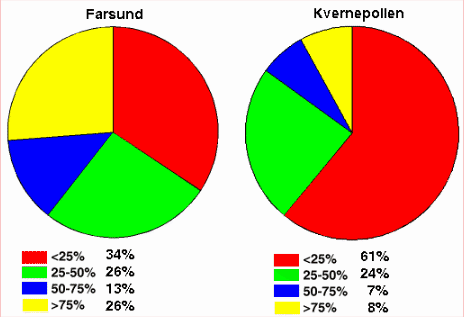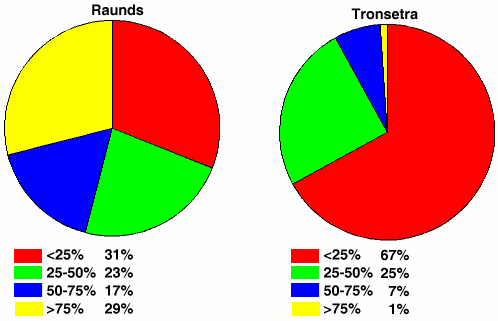
Figure 3: amount of cortex a:Farsund, b:Kvernepollen
Turning to Norwegian sites, raw material procurement is obviously an
importantfactor as a variety of raw materials were used and often found on the samesite. These included not just
flint but
quartz,quartzite,
rhyolite, rockcrystal,
slate, etc. Someof these
non flint materials have specific sources, as in the case of
rhyolitecoming from the island of Bølmo in Western Norway.
In terms of humanchoice, why did they choose to exploit rhyolite?
This involved travellingto the source by boat, and transporting it as
nodules or finished productsthroughout its distribution in Western Norway.
Is the choice of rhyolitean ethnic marker in that a specific material was
associated with a particulartribe? Does possession of rhyolite proclaim
their origin in Western Norwayas opposed to groups originating in Eastern
Norway?
It could be argued that there is no choice involved,
in that a scarcityof flint determined that rhyolite would be exploited, but why not use, forexample, quartzite, which
was much easier to obtain. Looking at the next linkin the chaîne
opératoire, does rhyolite have any particularknapping properties
that recommend it so that the choice is technological?Does rhyolite have
advantages over other materials functionally, in thatit is more efficient
than, say, quartzite for specific tasks? This wouldbe revealed by the uses
of the tools at that phase of the operational sequence.
There are also choices in the means of raw material exploitation. The materialcan be processed at source, transported as nodules, pre-formed cores oras finished products. The two sites from Kvernepollen and Farsund can becontrasted in this aspect.
Though both are coastal sites, exploiting similarenvironmental resources, there is a difference in that pre-formed coreswere transported into Kvernepollen, whereas nodules were taken onto thesite at Farsund. This can easily be illustrated by looking at the cortical element of the debitage (Fig. 3). The pattern from Farsund is typical ofknapping from cortical nodules. The pattern from Kvernepollen illustratesa lack of cortex that indicates primary reduction took place elsewhere.

Figure 3: amount of cortex a:Farsund, b:Kvernepollen
Also there were 10 primary flakes (flakes with 100% cortex) at Farsund and some of the cores are merely nodules with a few flakes removed. The knapper appears to have been testing the nodules for suitability and in some cases rejected them at that stage. This would suggest that there was a local source of flint. The pattern from Farsund is similar to the English Mesolithic site of Raunds where cortical nodules were also being knapped (Fig. 4). It could be suggested that these different patterns are a result of scarcity of flint in the later period when Kvernepollen was occupied.
However, the site of Tronsetra, which is dated c.7250 BP, has a similar patternto Kvernepollen. Transporting pre-formed cores would seem a preferable strategyat Tronsetra, which is located in the mountains at c.800m above sea leveland 100 kilometres from the coast.

Figure 4: amount of cortex a: Raunds b: Tronsetra
The significance is that the differences are not necessarily related to time, but also to choice. Other sites (for example from Songa, Telemark, in Coulson 1986) in the mountains have corticalnodules, so not taking them to Tronsetra was from choice, not necessity.
Quartzite was extensively used at Kvernepollen (see Fig.6), whereas it was virtually absent at Farsund,even though quartzite is available locally in both areas and throughoutthe chronological period. Is this from scarcity of flint or from choice? In other words, where flint was available, was it the preferred material over quartzite? Alternatively,if the social dynamics and subsistence strategy involved small, highly mobile,groups (such as on hunting expeditions), the choice was to take flint aspre-formed cores and use quartzite as required, as opposed to occupyingsites where flint was available. This choice of raw material procurementstrategy may be a cultural marker rather than a necessity forced on thepeople by the availability of flint. Sites are found where flint is broughtin as nodules and where quartzite is used (Songa, Telemark), suggestingthat different strategies of raw material procurement are chosen, ratherthan simply determined by available resources.
©
Internet Archaeology
Last updated: Thu Mar 20 1997